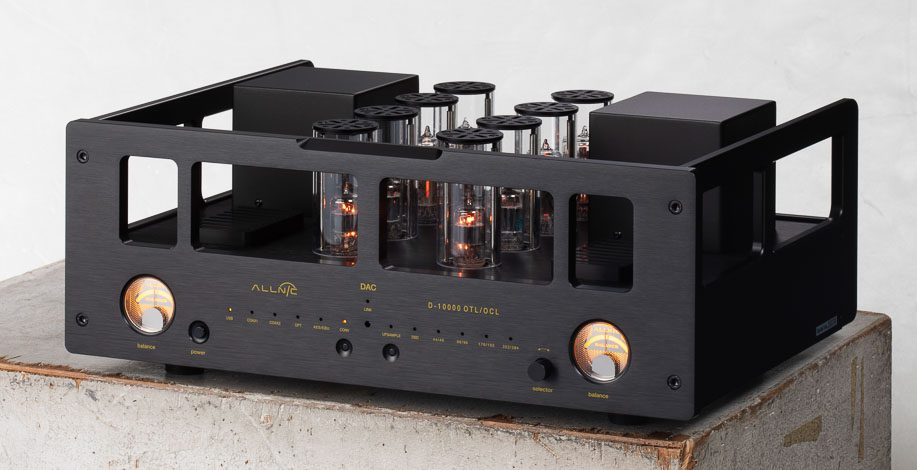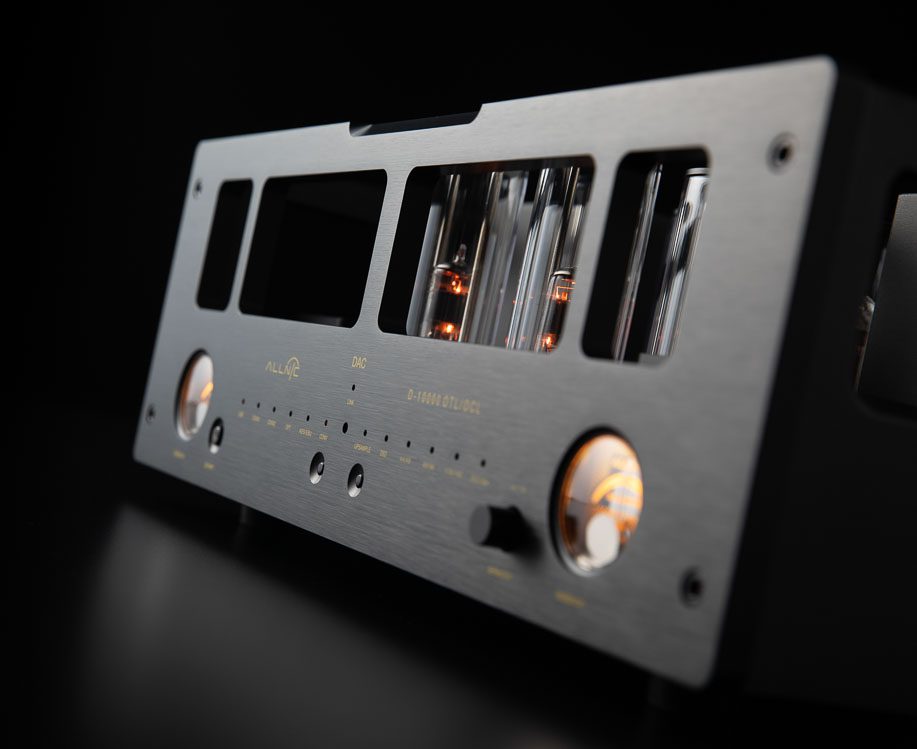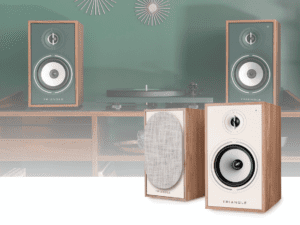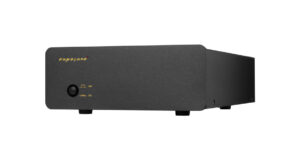
There are several ways to crack the ‘Big DAC’ nut. You can eschew conventional DACs in favour of making your own design; Chord Electronics and dCS being prime examples. Or, taking the DAC as a given, you can engineer the bejesus out of the rest of the circuit. It’s this second route that Allnic Audio has taken with its D-10000 DAC. In auditioning, the results more than pay dividends. The full name of this device is the ‘Allnic Audio D-10000 OTL/OCL DAC’. Those extra six letters mark this converter out for greatness.
Those who like their valve/tube amps might recognise ‘OTL’ or ‘output transformer-less’. As the name suggests, OTL designs remove the transformer from the output stage of valve/tube circuits. Removing much of the iron and wire in the process. OTL designs feature in amplifiers like David Berning, Linear Tube, and Atma-Sphere. However, Allnic uses an OTL in the output stage of its DAC.
The other three-letter acronym (OCL) is short for ‘output capacitor-less’. This means Allnic also does away with any capacitors in the signal path of the DAC’s output stage. Once again, this is unheard of in most amplifier circuits and is unique in DAC designs.
Why is this important? Two of the biggest sources of audio electronic coloration are the output transformers and capacitors in the signal path. They put several large sources of distortion between the digital conversion and the amplifier. Some might like that distortion, but it’s still a distortion.
Breed traits
However, those who have had first-hand experience with OTL designs point to the immediacy and lack of coloration as characteristics of the breed. The D-10000 does nothing to change that observation. Also, designers strive to limit the impact of capacitors in any output stage. Once again, in listening to the D-10000, the signature dynamic freedom and grain-free high-frequency performance of low-or-no capacitor output stages shines through and more than applies here.
Were the Allnic Audio D-10000 simply a basic digital circuit with a ‘pimped out’ output stage sporting two pentode/triode 7258 tubes, two twin-triode 12AU7 tubes, and four 6C19P triodes, we’d be happy. However, Allnic Audio didn’t leave the digital part alone, either. And this could be one of those parts where things go very wrong, very fast, because people with years of experience in analogue engineering are not automatically gifted with digital audio smarts. Fortunately, Allnic’s founder and designer Kang Su Park called on the digital skills of fellow Korean audio experts, Waversa Systems. Waversa’s stamp on the D-10000 means the DAC can convert PCM signals to DSD or upsample PCM in multiples up to 352kHz or 384kHz.
Exceptional Standards
Like all Allnic designs, the D-10000 is finished to an exceptional standard throughout and reminiscent of classic valve/tube amp designs of the Golden Age of the late 1950s/early 1960s. The two glowing meters for biasing and tube health aid that look, but aside from a few orange LEDs, you could be mistaken for thinking it a new-old-stock Scott or Marantz tuner from 60 or more years ago.
Allnic Audio also makes several OTL/OCL line-stage preamplifiers, but don’t think you need to use that degree of sonic performance to hear what the D-10000 can do; you can hear its character shining through on even the humblest amplifiers.

We’ve already touched on a few of the ‘breed characteristics’ common to OTL/OCL designs (low coloration, unobstructed dynamic range), but there’s one important consideration that perhaps defines everything about the D-10000; the way it represents an ideal line-level load for an amplifier. It’s practically an impedance archetype that comes across as an exceptionally low-noise, powerfully engaging sound from the first bars of the first piece of music you play. It doesn’t matter whether that is Barber’s Adagio or Justin Bieber’s ‘Love Yourself’; those first bars come as something of a shock, and the rest follow suit.
Big and bold
Throughout, the sound could be described as big and bold. Not in an overblown way, just in that full and rich way of open-reel or good vinyl. It doesn’t try to replicate the sound of older formats – it still has that clean and direct sound full of detail and information that the format does so well. However, it’s also got that cogent scale and size that vinyl does so well. What I mean is when listening to a small orchestral piece, moving down to a small jazz combo or string quartet, then trading up to something with maximum bombast (usually Mahler), the size and scale of the music changes, but has a sense of body that is often missing from digital replay.
Allnic’s D-10000 DAC points to an interesting dichotomy in digital audio reviewing. The vocabulary used to write about digital and analogue are often very different. But with the Allnic, I found my words tended more toward the analogue. As I said, not in an artificial way; more that the music sounded more vivid and ‘real’; full-bodied and enjoyable rather than cool. Unless you are at the very top of the digital audio tree, this will make a lot of digital audio move from ‘cool’ to ‘sterile’ sounding, and a lot of its rivals that go for a more organic sound do so at the expense of detail, which the D-10000 never does.
I Got Tone
Some of this comes down to its frankly lovely presentation. Guitarists often talk about ‘tone’ and spend a small fortune on pickups, pedals and power to try and create the right tone. Often, tone comes down as much to the player’s style as to the electronics, but the D-10000 is a natural at this tone thing; I think it’s something to do with the harmonic structure of its sound, or maybe the gain and output impedance being so good a match to preamplifier stages.
Still, you find yourself smiling along to wry vocals and playing air guitar along with the music that bit more. This is a hard and abstract thing to describe but immediately understandable on audition.
Allnic’s only DAC demands the best in music, however. And that might sound odd coming from someone who cited Justin Bieber a few paragraphs ago but stay with me on this. It showed the Justin Bieber track as surprisingly dynamic if incredibly forward and close-mic’d. What the Allnic D-10000 cannot abide are thin and compressed-sounding recordings. The tracks where there’s no harmonic joy to be had – such as ‘Californication’ by the Red Hot Chili Peppers from the album of the same name [Warners] – is thrown into sharp accent. Fortunately, the worst excesses of the Loudness War are behind us, but the Allnic D-10000 doesn’t suffer these musical fools gladly.
One of the best
It feels somehow wrong to criticise the Allnic D-1000 for the worst excesses of badly produced albums. In fairness, that was about as close as this gets to criticism. In almost every musical case it brought out the best of the music. It didn’t matter whether it was fed from a Hegel Mohican CD through S/PDIF, or via USB from an Innuos Statement Next Gen streamer. It gives music a structure and dimensionality that is hard to beat at any price.
There will always be those who claim a top-class DAC must always have a custom digital converter at its heart. But Allnic Audio’s D-10000 shows the importance of a well-produced output stage. It helps make one of the best DACs in the world. And that’s outside of matching OTL/OCL preamps and power amps. That could raise the game still further and perhaps be the best digital audio sound ever.
Technical specifications
- Type: OTL/OCL DAC
- Tubes/Valves used: 2 × 7258, 2 × 12AU7, 4 × 6C19P
- Digital inputs: 1 Optical (“Toslink”), 1 USB, 1 AES/EBU digital (XLR), 2 coaxial digital (RCA). Can be configured at factory as 2 COAX, 1 COAX/1 BNC, or 2 BNC
- Analogue outputs: One pair unbalanced (RCA), One pair balanced (XLR)
- DAC:Dual mono ES9018K2M SABRE 32 Reference Audio DACs
- Formats supported: DoP SD 64, DSD 128, PCM 44.1 KHz, 48 KHz, 88.2 KHz, 96 KHz, 176.4 KHz, 192 KHz, 352.8 KHz and 384 KHz.
- Output voltage: 4V RMS (can be fixed at 1.6V RMS at factory)
- Output impedance: 50Ω
- Finishes: Black, natural aluminium
- Dimensions (W×D×H): 43 × 32 × 17cm
- Weight: 13.06kg
- Price: $19,000
Manufacturer
Allnic Audio
International distributor
Kevalin Audio
+1 503-292-5592
Tags: ALLNIC AUDIO D-10000 DAC
By Alan Sircom
More articles from this authorRead Next From Review
See all
PrimaLuna EVO 100 phono preamplifier
- Apr 22, 2024

Reiki Audio SuperSwitch Master Pro + Servant Pro
- Mar 27, 2024

Melco Audio N1-S38 music server
- Mar 27, 2024











